
Ogcocephalidae is a family of anglerfish specifically adapted for a benthic lifestyle of crawling about on the seafloor. Ogcocephalid anglerfish are sometimes referred to as batfishes, deep-sea batfishes, handfishes, and seabats. They are found in tropical and subtropical oceans worldwide. They are mostly found at depths between 200 and 3,000 m, but have been recorded as deep as 4,000 m (13,000 ft). A few species live in much shallower coastal waters and, exceptionally, may enter river estuaries.

Ogcocephalus vespertilio, the Brazilian batfish or seadevil, is a species of marine ray-finned fish belonging to the family Ogcocephalidae, the deep sea batfishes. This species is found in the Western Atlantic Oceean. The Brazilian batfsish is the type species of the genus Ogcocephalus.

The red-lipped batfish or Galápagos batfish is a fish of unusual morphology found around the Galápagos Islands and off Peru at depths of 3 to 76 m (Froese, Rainer; Pauly, Daniel 2016). Red-lipped batfish are closely related to rosy-lipped batfish, which are found near Cocos Island off the Pacific coast of Costa Rica. This fish is mainly known for its bright red lips. Batfish are not good swimmers; they use their highly adapted pectoral, pelvic and anal fins to "walk" on the ocean floor. When the batfish reaches maturity, its dorsal fin becomes a single spine-like projection.

Ogcocephalus parvus, the roughback batfish, is a species of marine ray-finned fish belonging to the family Ogcocephalidae, the batifishes. This species has a wide distribution in the Western Atlantic Ocean.

Halieutopsis is a genus of marine ray-finned fishes beloning to the family Ogcocephalidae, the deep sea batfishes. The species in this genus are found in the Indian and Pacific Oceans.

Malthopsis, the gnome batfishes or triangular batfishes, is a genus of marine ray-finned fishes belonging to the family Ogcocephalidae, the deep sea batfishes. The triangular batfishes are distributed throughout the warmer waters of the world, although they are absent from the Eastern Atlantic Ocean. The genus was originally proposed in 1891 by the British naturalist Alfred W. Alcock.

Dibranchus is a genus of marine ray-finned fishes belonging to the family Ogcocephalidae, the deep sea batfishes. The fishes in this genus are widely distributed in the Atlantic, Indian and Pacific Oceans.
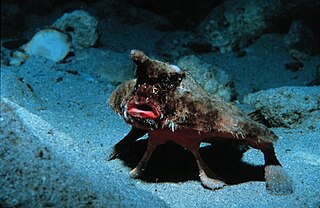
Ogcocephalus is a genus of marine ray-finned fishes belonging to the family Ogcocephalidae, the deep sea batfishes. The species in this genus are found in the Eastern Pacific Ocean and Western Atlantic Ocean, with most species in the eastern Atlantic Ocean where they live at shallower depths than the other ogcocephalid genera.
Solocisquama is a genus of marine ray-finned fishes belonging to the family Ogcocephalidae, the deep sea batfishes. The species in this genus are benthic fishes found in deep waters in the Indian and Pacific Oceans.
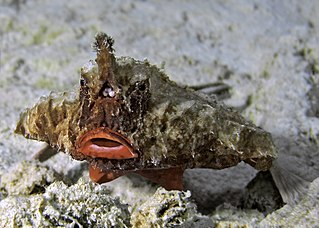
Ogcocephalus corniger, the longnose batfish, is a species of ray-finned fish belonging to the family Ogcocephalidae, the deep sea batfishes. This fish is found at depths between 29 and 230 m in the Atlantic Ocean, ranging from North Carolina to the Gulf of Mexico and the Bahamas. Like other members of the family Ogcocephalidae, it has a flat triangular body with coloring varying from yellowish to purple with pale, round spots. The lips are orange-red. Projecting from its head is a characteristic structure that is shared by other anglerfish.
Halieutichthys bispinosus, the two-spine batfish or spiny batfish, is a species of marine ray-finned fish belonging to the family Ogcocephalidae, the deep sea batfishes or seabats. This species is found in the Western Atlantic Ocean.
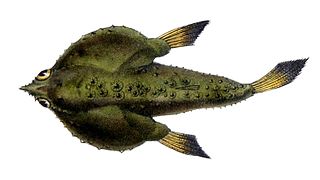
Ogcocephalus notatus, the marked batfish, is a species of ray-finned fish belonging to the family Ogcocephalidae, the deep sea batfishes. It is found in the tropical western Atlantic Ocean.
Halieutopsis ingerorum, Ingers' deepsea batfish, is a species of ray-finned fish belonging to the family Ogcocephalidae, the deep sea batfishes. This fish is found in the western Indian Ocean.
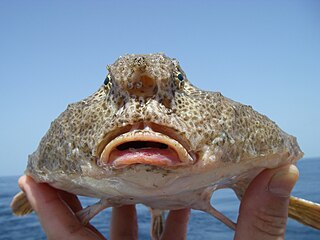
Ogcocephalus declivirostris, the slantbrow batfish, is a species of ray-finned fish belonging to the family Ogcocephalidae, the deep sea batfishes. This species is found in the western Atlantic Ocean from the northern Gulf of Mexico to the Straits of Florida.

Ogcocephalus pantostictus, the spotted batfish, is a species of ray-finned fish belonging to the family Ogcocephalidae, the deep sea batfishes. It is found in the western Atlantic Ocean, somewhat restricted to the northern and the western Gulf of Mexico.
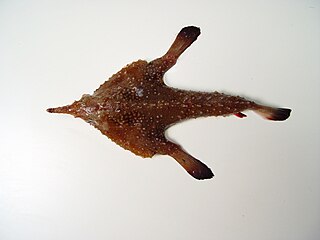
Ogcocephalus pumilus, the dwarf batfish, is a species of ray-finned fish belonging to the family Ogcocephalidae, the deep sea batfishes. It is found in the western Atlantic Ocean. It is the smallest species in the genus Ogcocephalus.
Ogcocephalus rostellum, the palefin batfish, is a species of ray-finned fish belonging to the family Ogcocephalidae, the deep sea batfishes. It is found in the western Atlantic Ocean.

Ogcocephalus cubifrons, the spotted batfish or polka-dot batfish, is a species of ray-finned fish belonging to the family Ogcocephalidae, the deep sea batfishes. This is an uncommon demersal fish found in the Western Atlantic Ocean and the southern Gulf of Mexico, in the United States, Mexico and the Bahamas.

Ogcocephalus nasutus, the shortnose batfish, is a species of ray-finned fish belonging to the family Ogcocephalidae, the deep sea batfishes. This species is found in the western Atlantic Ocean and the Caribbean.

The Caribbean batfish, also known as the two-spine batfish, is a species of marine ray-finned fish belonging to the family Ogcocephalidae, the deep sea batfishes or seabats. This species is found in the Western Atlantic Ocean.
















